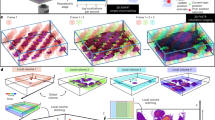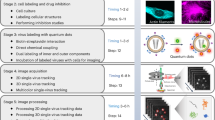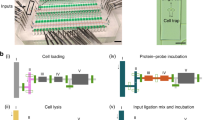Abstract
Optical tweezers use the momentum of photons to trap and manipulate microscopic objects, contact-free, in three dimensions. Although this technique has been widely used in biology and nanotechnology to study molecular motors, biopolymers and nanostructures, its application to study viruses has been very limited, largely due to their small size. Here, using optical tweezers that can simultaneously resolve two-photon fluorescence at the single-molecule level, we show that individual HIV-1 viruses can be optically trapped and manipulated, allowing multi-parameter analysis of single virions in culture fluid under native conditions. We show that individual HIV-1 differs in the numbers of envelope glycoproteins by more than one order of magnitude, which implies substantial heterogeneity of these virions in transmission and infection at the single-particle level. Analogous to flow cytometry for cells, this fluid-based technique may allow ultrasensitive detection, multi-parameter analysis and sorting of viruses and other nanoparticles in biological fluid with single-molecule resolution.
This is a preview of subscription content, access via your institution
Access options
Subscribe to this journal
Receive 12 print issues and online access
$259.00 per year
only $21.58 per issue
Buy this article
- Purchase on Springer Link
- Instant access to full article PDF
Prices may be subject to local taxes which are calculated during checkout






Similar content being viewed by others
References
Ashkin, A., Dziedzic, J. M., Bjorkholm, J. E. & Chu, S. Observation of a single-beam gradient force optical trap for dielectric particles. Opt. Lett. 11, 288–290 (1986).
Grier, D. G. A revolution in optical manipulation. Nature 424, 810–816 (2003).
Neuman, K. C. & Block, S. M. Optical trapping. Rev. Sci. Instrum. 75, 2787–2809 (2004).
Marago, O. M., Jones, P. H., Gucciardi, P. G., Volpe, G. & Ferrari, A. C. Optical trapping and manipulation of nanostructures. Nature Nanotech. 8, 807–819 (2013).
Qian, B., Montiel, D., Bregulla, A., Cichos, F. & Yang, H. Harnessing thermal fluctuations for purposeful activities: the manipulation of single micro-swimmers by adaptive photon nudging. Chem. Sci. 4, 1420–1429 (2013).
Wang, M. D. Manipulation of single molecules in biology. Curr. Opin. Biotechnol. 10, 81–86 (1999).
Perkins, T. T., Quake, S. R., Smith, D. E. & Chu, S. Relaxation of a single DNA molecule observed by optical microscopy. Science 264, 822–826 (1994).
Heller, I. et al. STED nanoscopy combined with optical tweezers reveals protein dynamics on densely covered DNA. Nature Methods 10, 910–916 (2013).
Aubin-Tam, M. E., Olivares, A. O., Sauer, R. T., Baker, T. A. & Lang, M. J. Single-molecule protein unfolding and translocation by an ATP-fueled proteolytic machine. Cell 145, 257–267 (2011).
Bormuth, V., Varga, V., Howard, J. & Schaffer, E. Protein friction limits diffusive and directed movements of kinesin motors on microtubules. Science 325, 870–873 (2009).
Gross, S. P. Application of optical traps in vivo. Methods Enzymol. 361, 162–174 (2003).
Vale, R. D. Microscopes for fluorimeters: the era of single molecule measurements. Cell 135, 779–785 (2008).
Yanagida, T., Iwaki, M. & Ishii, Y. Single molecule measurements and molecular motors. Phil. Trans. R. Soc. Lond. B 363, 2123–2134 (2008).
Stigler, J., Ziegler, F., Gieseke, A., Gebhardt, J. C. M. & Rief, M. The complex folding network of single calmodulin molecules. Science 334, 512–516 (2011).
Tinoco, I. Jr Force as a useful variable in reactions: unfolding RNA. Annu. Rev. Biophys. Biomol. Struct. 33, 363–385 (2004).
Bosanac, L., Aabo, T., Bendix, P. M. & Oddershede, L. B. Efficient optical trapping and visualization of silver nanoparticles. Nano Lett. 8, 1486–1491 (2008).
Ploschner, M., Cizmar, T., Mazilu, M., Di Falco, A. & Dholakia, K. Bidirectional optical sorting of gold nanoparticles. Nano Lett. 12, 1923–1927 (2012).
Tong, L., Miljkovic, V. D. & Kall, M. Alignment, rotation, and spinning of single plasmonic nanoparticles and nanowires using polarization dependent optical forces. Nano Lett. 10, 268–273 (2010).
Geiselmann, M. et al. Three-dimensional optical manipulation of a single electron spin. Nature Nanotech. 8, 175–179 (2013).
Reece, P. J. et al. Characterization of semiconductor nanowires using optical tweezers. Nano Lett. 11, 2375–2381 (2011).
Chen, Y. F., Serey, X., Sarkar, R., Chen, P. & Erickson, D. Controlled photonic manipulation of proteins and other nanomaterials. Nano Lett. 12, 1633–1637 (2012).
Pauzauskie, P. J. et al. Optical trapping and integration of semiconductor nanowire assemblies in water. Nature Mater. 5, 97–101 (2006).
Ashkin, A. & Dziedzic, J. M. Optical trapping and manipulation of viruses and bacteria. Science 235, 1517–1520 (1987).
Lauffer, M. A. & Stevens, C. L. Structure of the tobacco mosaic virus particle; polymerization of tobacco mosaic virus protein. Adv. Virus Res. 13, 1–63 (1968).
Newman, J. & Swinney, H. L. Length and dipole moment of TMV by laser signal-averaging transient electric birefringence. Biopolymers 15, 301–315 (1976).
Knipe, D. et al. Fields Virology (Lippincott, Williams & Wilkins, 2007).
Klein, J. S. & Bjorkman, P. J. Few and far between: how HIV may be evading antibody avidity. PLoS Pathogens 6, e1000908 (2010).
Bendix, P. M. & Oddershede, L. B. Expanding the optical trapping range of lipid vesicles to the nanoscale. Nano Lett. 11, 5431–5437 (2011).
Cheng, W., Hou, X. & Ye, F. Use of tapered amplifier diode laser for biological-friendly high-resolution optical trapping. Opt. Lett. 35, 2988–2990 (2010).
Kim, J. H., Song, H., Austin, J. L. & Cheng, W. Optimized infectivity of the cell-free single-cycle human immunodeficiency viruses type 1 (HIV-1) and its restriction by host cells. PLoS ONE 8, e67170 (2013).
McDonald, D. et al. Visualization of the intracellular behavior of HIV in living cells. J. Cell Biol. 159, 441–452 (2002).
Schaeffer, E., Geleziunas, R. & Greene, W. C. Human immunodeficiency virus type 1 Nef functions at the level of virus entry by enhancing cytoplasmic delivery of virions. J. Virol. 75, 2993–3000 (2001).
Accola, M. A., Ohagen, A. & Gottlinger, H. G. Isolation of human immunodeficiency virus type 1 cores: retention of Vpr in the absence of p6(gag). J. Virol. 74, 6198–6202 (2000).
Hou, X. & Cheng, W. Single-molecule detection using continuous wave excitation of two-photon fluorescence. Opt. Lett. 36, 3185–3187 (2011).
Hou, X. & Cheng, W. Detection of single fluorescent proteins inside eukaryotic cells using two-photon fluorescence. Biomed. Opt. Express 3, 340–353 (2012).
Cheng, W., Arunajadai, S. G., Moffitt, J. R., Tinoco, I. Jr & Bustamante, C. Single-base pair unwinding and asynchronous RNA release by the hepatitis C virus NS3 helicase. Science 333, 1746–1749 (2011).
Briggs, J. A. G., Wilk, T., Welker, R., Krausslich, H. G. & Fuller, S. D. Structural organization of authentic, mature HIV-1 virions and cores. EMBO J. 22, 1707–1715 (2003).
Tolic-Norrelykke, S. F. et al. Calibration of optical tweezers with positional detection in the back focal plane. Rev. Sci. Instrum. 77, 103101 (2006).
Burton, D. R. et al. Efficient neutralization of primary isolates of HIV-1 by a recombinant human monoclonal antibody. Science 266, 1024–1027 (1994).
Kwong, P. D. et al. Structure of an HIV gp120 envelope glycoprotein in complex with the CD4 receptor and a neutralizing human antibody. Nature 393, 648–659 (1998).
Liu, J., Bartesaghi, A., Borgnia, M. J., Sapiro, G. & Subramaniam, S. Molecular architecture of native HIV-1 gp120 trimers. Nature 455, 109–113 (2008).
Chertova, E. et al. Envelope glycoprotein incorporation, not shedding of surface envelope glycoprotein (gp120/SU), is the primary determinant of SU content of purified human immunodeficiency virus type 1 and simian immunodeficiency virus. J. Virol. 76, 5315–5325 (2002).
Zhu, P. et al. Distribution and three-dimensional structure of AIDS virus envelope spikes. Nature 441, 847–852 (2006).
Gittes, F. & Schmidt, C. F. Interference model for back-focal-plane displacement detection in optical tweezers. Opt. Lett. 23, 7–9 (1998).
Klasse, P. J. The molecular basis of HIV entry. Cell Microbiol. 14, 1183–1192 (2012).
Parrish, N. F. et al. Phenotypic properties of transmitted founder HIV-1. Proc. Natl Acad. Sci. USA 110, 6626–6633 (2013).
Berger, E. A. et al. A new classification for HIV-1. Nature 391, 240 (1998).
Checkley, M. A., Luttge, B. G. & Freed, E. O. HIV-1 envelope glycoprotein biosynthesis, trafficking, and incorporation. J. Mol. Biol. 410, 582–608 (2011).
Johnson, M. C. Mechanisms for Env glycoprotein acquisition by retroviruses. AIDS Res. Hum. Retrovir. 27, 239–247 (2011).
Sundquist, W. I. & Krausslich, H. G. HIV-1 assembly, budding, and maturation. Cold Spring Harb. Perspect. Med. 2, a006924 (2012).
Muranyi, W., Malkusch, S., Muller, B., Heilemann, M. & Krausslich, H. G. Super-resolution microscopy reveals specific recruitment of HIV-1 envelope proteins to viral assembly sites dependent on the envelope C-terminal tail. PLoS Pathogens 9, e1003198 (2013).
Arunajadai, S. G. & Cheng, W. Step detection in single-molecule real time trajectories embedded in correlated noise. PLoS ONE 8, e59279 (2013).
Acknowledgements
This work was supported by a National Institutes of Health (NIH) Director's New Innovator Award (1DP2OD008693-01, to W.C.), a National Science Foundation CAREER Award (CHE1149670, to W.C.) and also in part by a research grant from the March of Dimes Foundation (5-FY10-490, to W.C.). The authors thank A. Ono and A. Telesnitsky for discussions and Cheng Lab members, especially M. DeSantis, for critical reading of the manuscript. The MATLAB code for analysis of transmission electron microscopy images of polystyrene beads was provided by M. DeSantis. The following reagents were obtained through the AIDS Research and Reference Reagent Program, Division of AIDS, National Institute of Allergy and Infectious Diseases (NIAID), NIH: pNL4-3 from M. Martin; pNL4-3.Luc.R-E- from N. Landau; pEGFP–Vpr from W. C. Greene; TZM-bl cells from J. C. Kappes, X. Wu and Tranzyme Inc; b12 antibody from D. Burton and C. Barbas.
Author information
Authors and Affiliations
Contributions
W.C. conceived and directed the project. H.S. and J.H.K. prepared experimental materials. Y.P., H.S., J.H.K., X.H. and W.C. conducted the experiments. Y.P., H.S., J.H.K., X.H. and W.C. performed the analysis. Y.P. and W.C. wrote the paper.
Corresponding author
Ethics declarations
Competing interests
The authors declare no competing financial interests.
Supplementary information
Supplementary Information
Supplementary Information (PDF 4277 kb)
Supplementary Movie
Supplementary Movie (AVI 1583 kb)
Rights and permissions
About this article
Cite this article
Pang, Y., Song, H., Kim, J. et al. Optical trapping of individual human immunodeficiency viruses in culture fluid reveals heterogeneity with single-molecule resolution. Nature Nanotech 9, 624–630 (2014). https://doi.org/10.1038/nnano.2014.140
Received:
Accepted:
Published:
Issue Date:
DOI: https://doi.org/10.1038/nnano.2014.140
This article is cited by
-
3D printed microfluidic lab-on-a-chip device for fiber-based dual beam optical manipulation
Scientific Reports (2021)
-
Optical manipulation of a dielectric particle along polygonal closed-loop geometries within a single water droplet
Scientific Reports (2021)
-
Single entity resolution valving of nanoscopic species in liquids
Nature Nanotechnology (2018)
-
Sorting of small infectious virus particles by flow virometry reveals distinct infectivity profiles
Nature Communications (2015)
-
Probing the Raman-active acoustic vibrations of nanoparticles with extraordinary spectral resolution
Nature Photonics (2015)



